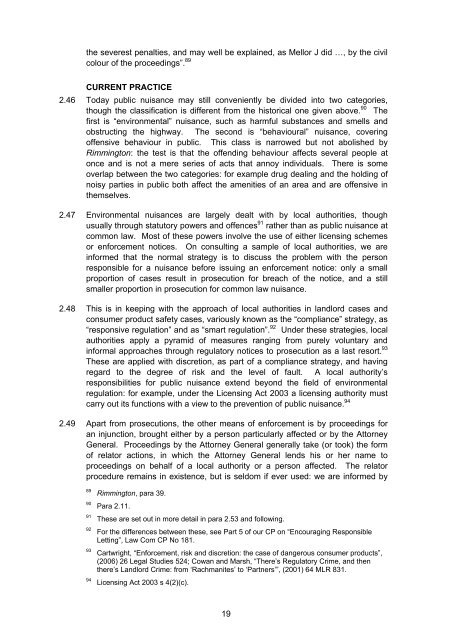public nuisance and outraging public decency - Law Commission
public nuisance and outraging public decency - Law Commission
public nuisance and outraging public decency - Law Commission
Create successful ePaper yourself
Turn your PDF publications into a flip-book with our unique Google optimized e-Paper software.
the severest penalties, <strong>and</strong> may well be explained, as Mellor J did …, by the civil<br />
colour of the proceedings”. 89<br />
CURRENT PRACTICE<br />
2.46 Today <strong>public</strong> <strong>nuisance</strong> may still conveniently be divided into two categories,<br />
though the classification is different from the historical one given above. 90 The<br />
first is “environmental” <strong>nuisance</strong>, such as harmful substances <strong>and</strong> smells <strong>and</strong><br />
obstructing the highway. The second is “behavioural” <strong>nuisance</strong>, covering<br />
offensive behaviour in <strong>public</strong>. This class is narrowed but not abolished by<br />
Rimmington: the test is that the offending behaviour affects several people at<br />
once <strong>and</strong> is not a mere series of acts that annoy individuals. There is some<br />
overlap between the two categories: for example drug dealing <strong>and</strong> the holding of<br />
noisy parties in <strong>public</strong> both affect the amenities of an area <strong>and</strong> are offensive in<br />
themselves.<br />
2.47 Environmental <strong>nuisance</strong>s are largely dealt with by local authorities, though<br />
usually through statutory powers <strong>and</strong> offences 91 rather than as <strong>public</strong> <strong>nuisance</strong> at<br />
common law. Most of these powers involve the use of either licensing schemes<br />
or enforcement notices. On consulting a sample of local authorities, we are<br />
informed that the normal strategy is to discuss the problem with the person<br />
responsible for a <strong>nuisance</strong> before issuing an enforcement notice: only a small<br />
proportion of cases result in prosecution for breach of the notice, <strong>and</strong> a still<br />
smaller proportion in prosecution for common law <strong>nuisance</strong>.<br />
2.48 This is in keeping with the approach of local authorities in l<strong>and</strong>lord cases <strong>and</strong><br />
consumer product safety cases, variously known as the “compliance” strategy, as<br />
“responsive regulation” <strong>and</strong> as “smart regulation”. 92 Under these strategies, local<br />
authorities apply a pyramid of measures ranging from purely voluntary <strong>and</strong><br />
informal approaches through regulatory notices to prosecution as a last resort. 93<br />
These are applied with discretion, as part of a compliance strategy, <strong>and</strong> having<br />
regard to the degree of risk <strong>and</strong> the level of fault. A local authority’s<br />
responsibilities for <strong>public</strong> <strong>nuisance</strong> extend beyond the field of environmental<br />
regulation: for example, under the Licensing Act 2003 a licensing authority must<br />
carry out its functions with a view to the prevention of <strong>public</strong> <strong>nuisance</strong>. 94<br />
2.49 Apart from prosecutions, the other means of enforcement is by proceedings for<br />
an injunction, brought either by a person particularly affected or by the Attorney<br />
General. Proceedings by the Attorney General generally take (or took) the form<br />
of relator actions, in which the Attorney General lends his or her name to<br />
proceedings on behalf of a local authority or a person affected. The relator<br />
procedure remains in existence, but is seldom if ever used: we are informed by<br />
89 Rimmington, para 39.<br />
90 Para 2.11.<br />
91 These are set out in more detail in para 2.53 <strong>and</strong> following.<br />
92<br />
For the differences between these, see Part 5 of our CP on “Encouraging Responsible<br />
Letting”, <strong>Law</strong> Com CP No 181.<br />
93 Cartwright, “Enforcement, risk <strong>and</strong> discretion: the case of dangerous consumer products”,<br />
(2006) 26 Legal Studies 524; Cowan <strong>and</strong> Marsh, “There’s Regulatory Crime, <strong>and</strong> then<br />
there’s L<strong>and</strong>lord Crime: from ‘Rachmanites’ to ‘Partners’”, (2001) 64 MLR 831.<br />
94 Licensing Act 2003 s 4(2)(c).<br />
19

















